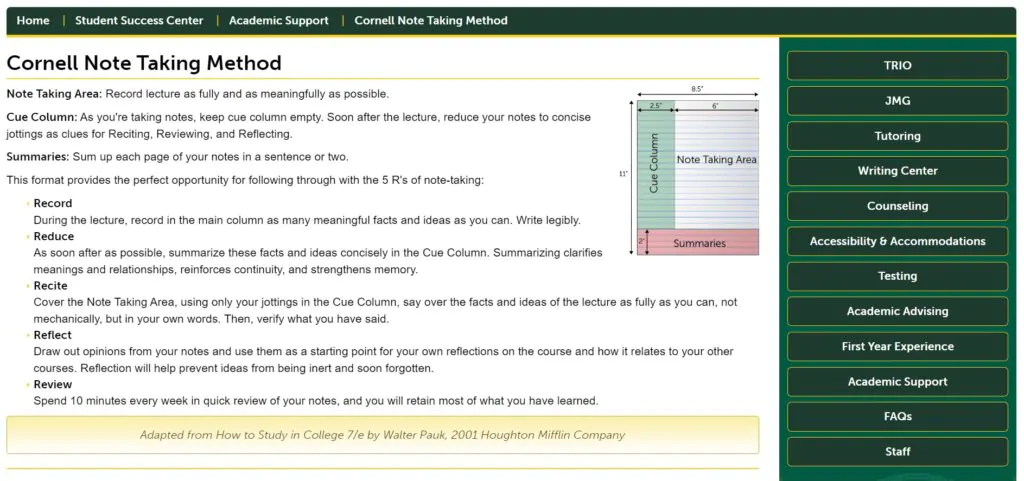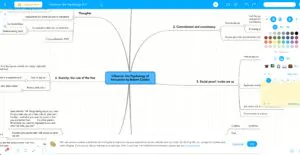Before going to college, ensure you know the different note taking methods you can use during lectures, presentations, and lessons.
To be a successful student, you must have a note-taking system that works for you. Taking notes forces you to pay attention and engage with the material presented in class. There are several note-taking techniques, and each student will find that they need to learn how they learn best. That said, you can learn how to take notes using a specific method and the best note taking apps, allowing you to leave class with a clearer understanding of what the teacher taught.
Most students have an idea in mind of what taking notes looks like. Outline notes using Roman numerals and capital letters are among the most common types of notes used in high school and elementary school. This changes in college.
In college, you can organize your notes based on what works best for your learning style. Thankfully, note-taking systems include several options. While you can always jot down your notes, the best way to keep track of them and use them to study is by having a note-taking system that works with how you learn. Here are six common note-taking options that you might want to consider.
If you want to set up your own note-taking system for your writing, I created just the thing. Click here to learn more.
Contents
1. The Cornell Method

Cornell note-taking is a systematic format that helps you organize notes in a controlled, but condensed, version. To use this method, you must draw a two-inch margin on the left-hand side of the paper, leaving a six-inch area on the left side. Then, write information on that left column, skipping a line or two when the professor changes topics. You will also write a cue in the left margin you marked off during the lecture. Finally, after the lecture, you try to complete the phrases and sentences you jotted down in class.
The main advantage of this effective note-taking method is its systematic nature. You can record anything you find of value, then pull out the main ideas into the summary section after class. It also makes for an easy review. Cover the notes with a piece of paper and read the cues to see how much you remember, then check your work to see if you are correct or incorrect.
This efficient note-taking method does not have many drawbacks. It can take a little while to get used to, but once you have it down, you can apply it to most lecture content. Because the Cornell method is so thorough, it works for just about any note-taking scenario. In addition, the summary and cue sections make it easier for students when reviewing your notes.
2. The Outlining Method
The outlining method of note-taking is the most commonly taught. It involves creating a Roman numeral style outline with the most general headings as the Roman numerals aligned to the left-hand side of the page, with subheadings underneath and indented to the right just a little for each level of subheading. A variation of this is to skip the Roman numerals in favor of bullet points but still indent to show where the subheadings begin and end.
One benefit of the outlining method is that you get an organized set of handwritten notes at the end of this process. The important points are easy to spot because they are the main Roman numeral headings. You can also quickly review for exams by turning those main points into questions. The challenge of this method is that it requires thought to pull out the key points properly. This can detract from your ability to think and listen. It also may not work if the teacher lectures quickly or if they tend to float from unrelated topics easily. This method works well with the best outliner software.
3. The Mapping Method

The mapping method makes a mind map of the main topic. To create this note-taking format, you will circle in the center of the paper and write the main topic inside. Then, as the lecture progresses, you will draw lines from that central point to branch out into other subtopics, with additional branches from those subtopics as needed.
One benefit of this note-taking strategy is that you can visualize the lecture. For many visual learners, this helps with retention. You do not have to think deeply during the lecture to get the information. Instead, jot down what is of interest and where it fits in the image, and you will have it later. The disadvantage of this format is it can be hard to tell when the teacher is going to a new branch on your map or when they are expounding on the one you have already drawn. For more, check out our round-up mind mapping software.
4. The Charting Method
The charting method of note-taking requires you to set up a chart with headings on your paper. Each heading, which you anticipate will be discussed in the lecture, goes at the top of each column. Then, as you listen, use your note-taking skills to fill in the boxes on your chart. This note-taking skill is advantageous because it reduces the amount of writing you have to take. You also have a visual chart that can help you memorize facts. The method works very well when you need to study comparisons and helps you keep track of statistics and facts if they are part of the lecture.
The disadvantage is that you have to know the appropriate categories before making your chart. This is challenging if your teacher doesn’t publish the lecture topic or assign reading prior to class. In addition, some consider it the most complicated option for organizing notes. Use the charting method when you want to learn facts and see how those facts connect. You also should use this method if you struggle to write notes under that professor because they talk quickly, and you can’t write fast enough. This method works quite with research note card software
5. The Sentence Method
With the sentence method, you will write new thoughts in sentence form, using your own words, on new lines, and number each as you go. Of course, you can use abbreviations or shorthand to make writing more straightforward, but this is the method. This is slightly more organized than simply writing a paragraph of information, which is a sign of good notes and one of the advantages of this system. It also lets you get more of information on your note-taking paper.
The disadvantage of this method is the sheer amount of information you must record. It can be hard to differentiate what the main points are. Also, if you want to organize your notes at a later date, you may find this challenging with this format. Use the sentence method when the lecture is content-heavy and well-organized. Then, you can focus on the lecture instead of the note-taking method, leading to more success.
6. The Boxing Method
The boxing method uses visually separated boxes on a page. It was designed to accommodate note-taking on digital devices, but pencil and paper learners can also use it. Within the boxes on the page, you will write important information on a particular main topic. The advantage of this note-taking method is that it is easy to do on a digital tool. It is pleasant to look at and helps you reduce the amount you write down. It works well for those with a visual learning style. However, starting this method can be time-intensive as you need to create your boxes and headings. In addition, it may not be the best method for unpredictable lecture periods.
If you want to learn more about any of these methods, it’s a good idea to study how academics work. In our guide, we profile the best research books.